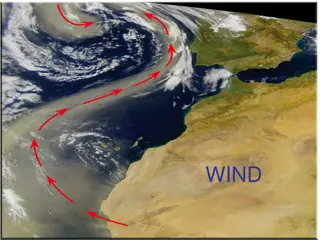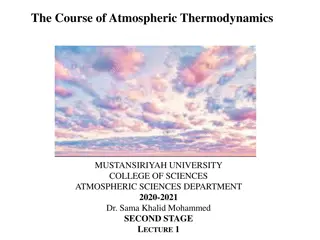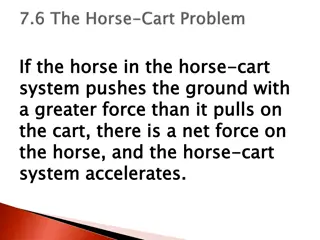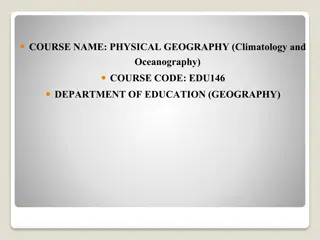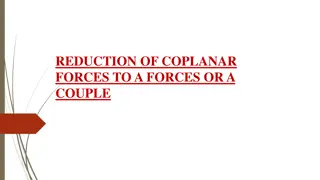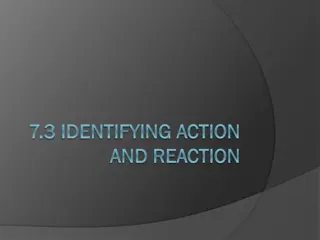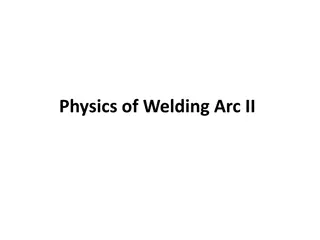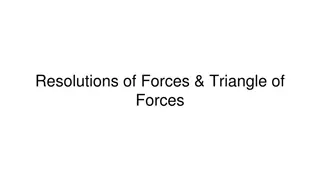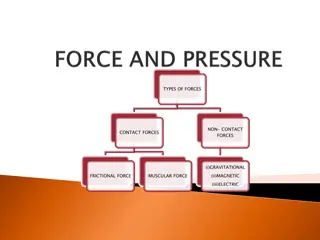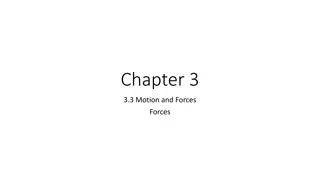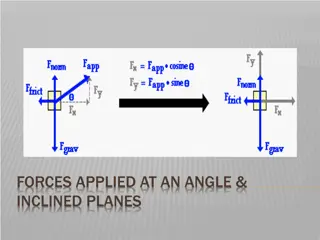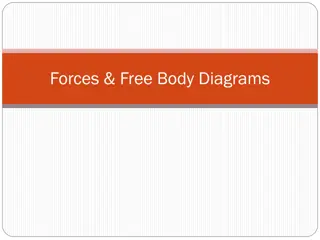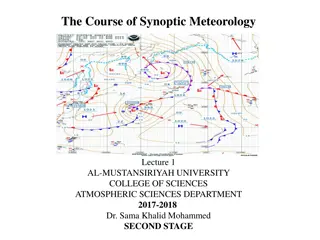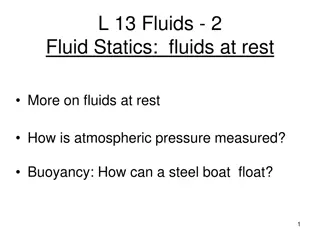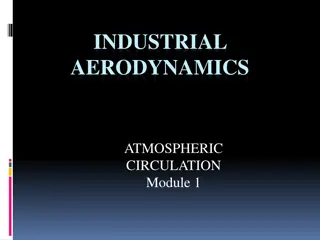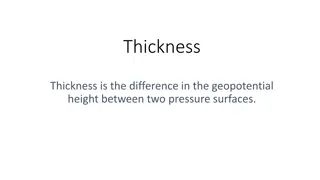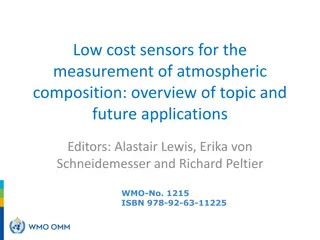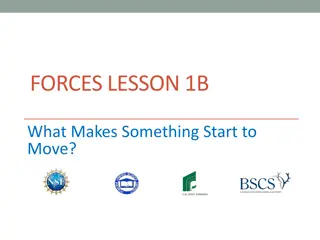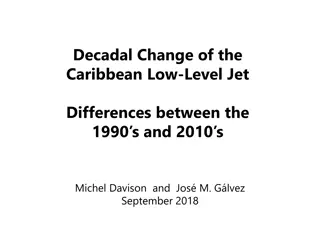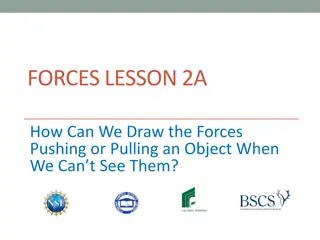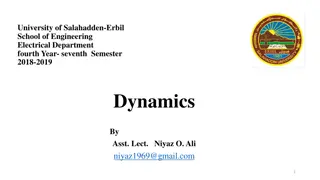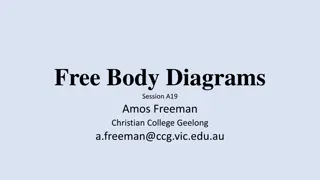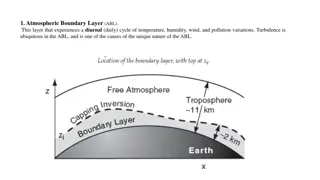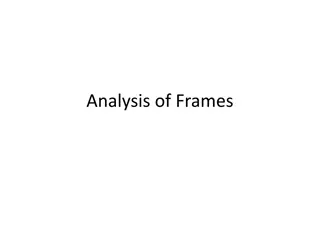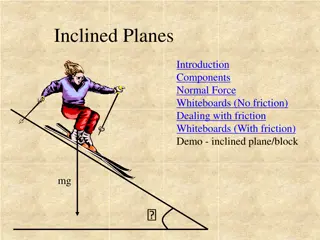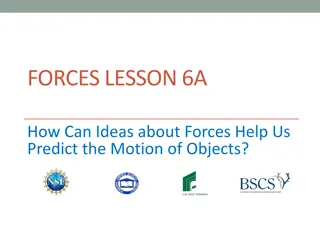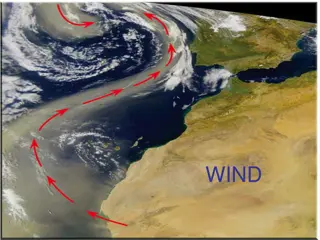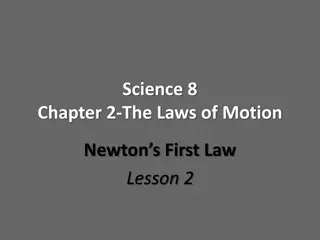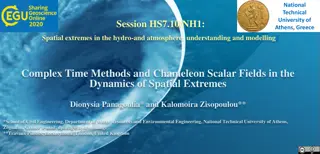Understanding Forces and Dynamics in Atmospheric Science
Exploring the forces acting on parcels of air in the atmosphere, including gravitational acceleration, pressure gradient acceleration, and viscosity. Delving into Lagrangian and Eulerian derivatives, advection, and transforming to a rotating frame with Coriolis effect. Enhance your knowledge of atmospheric dynamics and fluid mechanics.
Download Presentation

Please find below an Image/Link to download the presentation.
The content on the website is provided AS IS for your information and personal use only. It may not be sold, licensed, or shared on other websites without obtaining consent from the author. Download presentation by click this link. If you encounter any issues during the download, it is possible that the publisher has removed the file from their server.
E N D
Presentation Transcript
EART30351 Lecture 5
Forces on a parcel of air 1. Gravitational acceleration ?? ??= ??? A = vector from centre of Earth ME= mass of Earth We start with F = ma ?? ?? =? ?3? ? ? i.e. acceleration in an inertial frame is the force per unit mass dV/dt A
Forces on a parcel of air We start with F = ma 2. Pressure gradient acceleration ?? ?? =? w Pressure p ? v ? dz u i.e. acceleration in an inertial frame is the force per unit mass dy dx V = (u,v,w) ??? ????? ????? ? = ? ? ? ? + ?? ?? ?? = ?? ???? ?? ?? ???? ?? ??? ?????? = ? ?? ?? ?? ?? ??= 1 1. Gravitational acceleration ?? ??= ??? A = vector from centre of Earth ?3? ?? ?? ? ?? ??= 1 ???
Forces on a parcel of air cont Viscosity. For a Newtonian fluid: ?? ??=? is the dynamic coefficient of viscosity. However, viscosity is only important on very small scales (< 1 cm) in the atmosphere. More generally we use a frictional force -F So in an inertial frame we have: ??2? ?? ?? = 1 ??? ??? ?3? ? ? Pressure gradient acceleration Gravitational acceleration Friction
Lagrangian and Eulerian derivatives The relation between them is: F=ma applies to a parcel of air. We call the rate of change of a quantity following the parcel the Lagrangian or material derivative, denoted by full differentials (e.g. dT/dt). Rate of change of T at a point = Local heating/cooling of air at that point + Movement of warmer or colder air over the point The alternative is to define a field on a grid fixed in space, and calculate Eulerian derivatives denoted by partial derivatives, e.g T/ t). Eulerian = Lagrangian + advection
Advection ?? ??=?? ??+ ?.?? TT+ T T T+2 T V For a vector field the formula generalises P ?? ??=?? ??+ ?.? ? The advection term is quadratic in V. This makes the momentum equation non-linear and gives rise to chaotic motion and turbulence. Advection of momentum by the flow is what makes fluid mechanics so complicated Wind is blowing colder temperatures towards P it is advecting cold air Rate of advection = -V. T (m s-1 x K m-1 = K s-1 ) ?? ??=?? ?? ?.??
Transforming to a rotating frame - Coriolis Consider vector r in a stationary inertial frame I, with a frame R rotating about the z axis at angular velocity - xr yI yR r XR xr XI points into the screen
Transforming to a rotating frame Consider vector r in an inertial frame I, with frame R rotating about the z axis at angular velocity More generally: ?? ???= Apply this rule twice: ?? ??? ? ? - xr yI yR ??? ?? ? ??? ? ??? = ? ? ? ? r ??? ?? ??? ?? ? 2? ??+ ? ? r XR ?= xr XI ??? ?? ??? ?? ? 2? ?? ? ? r Coriolis Centrifugal ?= ?? ???= ? ? If r is constant in I,
Momentum equation in a rotating frame: ?? ?? = 1 ??? 2? ? ? ? ? ??? ?3? ? ? We combine the Centrifugal and gravitational terms to get the acceleration due to gravity g. Dropping the subscript R: ?? ??= 1 ??? 2? ? ? ? This equation applies in a frame of reference with its origin at the centre of the Earth and rotating with it.
Local frame of reference In this frame, x is East, y is North and z is up. The reference frame is different at each point on the Earth s surface but is the natural one in which to measure wind velocity, acceleration etc Surprisingly, transforming from a frame fixed to the Earth to a local frame only introduces terms O(V2/A) to the momentum equation, where A is the radius of the Earth From this point on we will be working in the local frame of reference
How big is the Coriolis force? = 2 /86400 = 7.27x10-5 rad s-1 For a car, v ~ 30 ms-1 so Coriolis 2 v ~ 0.006 ms-2 If car goes round corner with radius 1 km, centripetal acceleration (v2/R) ~ 1 ms-2 Artillery shell aimed at a point 10 km away, will be diverted by 22 m by Coriolis acceleration enough to require a correction
How big is the Coriolis force? = 2 /86400 = 7.27x10-5 rad s-1 For a car, v ~ 30 ms-1 so Coriolis 2 v ~ 0.004 ms-2 If car goes round corner with radius 1 km, centripetal acceleration (v2/R) ~ 1 ms-2 Artillery shell aimed at a point 10 km away, will be diverted by 22 m by Coriolis acceleration enough to require a correction For air motion around high and low pressure systems, the radius of curvature is ~ 103 km. Typical wind speed 10 ms-1 Centripetal Acceleration = 100/106 = 10-4 ms-2 Coriolis = 2 V = 1.4 x 10-3 ms-2
Components of the Coriolis Acceleration Coriolis acceleration = -2 xV Local frame of reference = 2 0,??? ,??? ?,?,? k and j are unit vectors up and northward at P k j = 2 (???? ???? ,???? , ???? ) P (i) Vertical component -2 ucos << g, can be neglected has components k and j along k and j On weather (synoptic) scales w ~ 1 cms-1 so it can be neglected too. So Coriolis = -2 sin (-v,u,0) = -f k x U (ii) j = cos , k = sin where is latitude f is the Coriolis parameter = 2 sin U is the horizontal velocity vector = (u,v,0) Local frame of reference
Final version of the momentum equation In local frame of reference: ?2 ? ?? ??= 1 ??? ?? ? ? ? + O We will see next time how this equation can be simplified.




